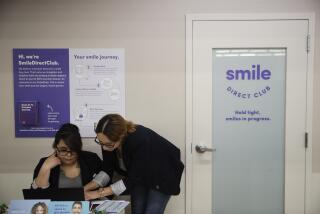The Beam Team : Suddenly Famous Developer of Dental Laser Keeps Its Focus on Tough Job Ahead
- Share via
Colette Cozean got her first taste of media stardom this week.
As chief executive of Premier Laser Systems Inc. in
Irvine, she was thrust from obscurity into the national spotlight when the Food and Drug Administration approved the tiny Irvine company’s laser system to remove tooth decay--a revolutionary event in dentistry.
In New York to meet with analysts when the announcement was made Wednesday, the pragmatic chief executive, scientist and mother of two went from one interview to another, appearing on all the major television networks and quoted on the front pages of newspapers.
Despite the sudden attention, Cozean, 38, maintained that her feet remain firmly planted on the ground.
“This isn’t just a media blitz for us,” said Cozean of the six-year campaign to develop the laser and win approval. “The company has worked very hard for a long time with limited resources.”
And she recognizes that more hard work lies ahead.
While Premier is the first to attain the Holy Grail status of FDA approval of a laser that repairs cavities without the pain of drilling, it still has to convince the nation’s 120,000 dentists--normally a reticent bunch--to pony up the $39,000 for the system. Then it must get the new equipment to them without any hitches.
From here, Cozean acknowledged, “it’s going to come down to execution.”
Premier has what analysts say is potentially a $4- billion-plus market all to itself. Other companies with competing lasers are thought to be at least 1 1/2 years from winning FDA approval.
But eventually, they say, Premier will face competition--and it had better be ready. For every entrepreneur who has parlayed a groundbreaking product into a billion-dollar business, there are dozens of others who have stumbled over marketing, manufacturing or distribution foul-ups.
“The major challenge is to get this product in the marketplace broadly and rapidly,” said analyst Tony Viscogliosi at Rodman & Renshaw.
Many analysts believe that Premier is up to the challenges ahead. And the main reason, they say, is Cozean.
“She’s the classic entrepreneur,” said John Westergaard, an analyst at Westergaard Online Systems Inc.
“She had a vision, she’s been able to raise the money and she’s got good credentials. She’s been very confident all along that this was going to work out.”
Scott Baily, senior analyst at BlueStone Capital Partners, said Cozean “is unlike any CEO I’ve ever come in contact with.”
Not only is she adept in the technical and medical arena, he said, but she also possesses impressive business acumen.
“She has the whole package,” he said. “The reason this company is at the forefront today is because of that woman.”
Ironically, Cozean once considered the laser business a waste of time.
A decade ago, as a young biomedical engineer, she was asked to head research and development at a new medical laser division of the drug giant Pfizer. Cozean rejected the offer, saying she’d never heard of a medical laser company that made money. Pfizer kept courting her, and a year later she joined the company.
In 1991, when Pfizer’s new management decided to sell the laser business, Cozean jumped at the chance. She rounded up $10 million from family, friends, investors and fellow employees and bought the unit. In November 1994, Premier went public, raising about $10 million.
Over the years, Premier has had some lean times. It nearly ran out of money a year ago when--believing approval of the dental laser was imminent--the FDA said it wanted more data. A secondary offering last fall brought in an additional $10 million and kept the company going.
Company executives say that’s ancient history now. By mid-morning Thursday, Premier had received 60 orders for its dental laser, and “the phone’s been ringing off the hook,” said T. Daniel Caruso Jr., senior vice president of sales and marketing.
But with just 49 employees, analysts say that Premier must quickly ramp up its organization. And when executives have time to catch their breath, they’ll need to reevaluate the entire business.
“Sometime in the next year or two,” said Jim McCamant, editor of the Medical Technology Stock Letter, “they have to say ‘What’s next?’ ”
Analyst Baily noted that throughout the media blitz of the last few days, Cozean has wisely refrained from making big pronouncements about the company’s prospects. Her first-year target is to capture 1% of the tooth-drilling market, which would translate into about $45 million in sales.
The company projects sales of 10,000 to 15,000 laser systems in the next 10 years.
“She doesn’t want the stock to go from $5 to $25 and then back down to $5,” if Premier fails to meet investors’ expectations, Baily said.
Nonetheless, expectations are riding high. Premier’s stock, which rose $1.625 a share on Wednesday, gained $2.625 more to close at $11 in Nasdaq trading Thursday. With 5.3 million shares changing hands, it was the 12th most active stock in the U.S. markets.
Cozean’s 2.9% stake is now worth $3.1 million.
Not bad, considering Premier has never turned a profit. In the fiscal year ended March 31, it lost $5.59 million on sales of $5.53 million.
Baily predicts that Premier will take in more than $20 million in its current fiscal year, and will turn profitable by the fourth quarter.
McCamant said that Premier will no doubt benefit by the publicity over the FDA announcement. In an unusual twist in dentistry, sales of the laser system “will be consumer-driven,” as patients who have heard about the pain-free technique will request the laser. “My guess is that will make their job easier.”
Also, analyst Baily noted, Premier is more than a one-product company. It sells other laser systems used on gums, as well as surgical and ophthalmic lasers. A few weeks ago, it acquired an ophthalmic laser company with $8 million in annual revenue.
Premier’s marketing must begin with training dentists. It is conducting one-day classes at five sites around the country.
Despite the FDA’s blessing, dentists are sure to have questions of their own about the safety and reliability of the laser system, said Ken Burrell, senior director of the American Dental Assn.’s Council on Scientific Affairs.
It took decades for the dental drill to gain widespread acceptance, he noted. Now dentists will require evidence that the laser represents a significant improvement over drills before investing. They’ll demand to know if the laser might damage the interior pulp of the tooth, or possibly crack the tooth surface.
“Being very conservative by nature, they know what they have is tried and true,” Burrell said.
(BEGIN TEXT OF INFOBOX / INFOGRAPHIC)
No Needles, No Drills
Recently approved laser technology replaces the dreaded dental drill with a quiet, painless method of treating cavities. How it works:
1. Erbium laser vaporizes damaged portion of tooth and kills cavity-causing bacteria.
2. Laser clears away small amount of tooth structure to create space for filling material that matches tooth color.
Average amount of time required to this point: 60 seconds
3. Filling applied and hardened by an argon laser.
Laser’s Advantages
* No drill: Painful heat, vibration and anxiety-producing whine are eliminated; test patients report only a tingling feeling and a slight popping sound.
* No shots: No anesthesia required in most cases.
* No secondary decay: Laser-treated area is free of cavity-causing bacteria; decay cannot resume beneath filling.
* Quicker: No waiting for anesthesia to take affect; no time-consuming drilling.
* More precise: Less of surrounding healthy tooth structure is removed.
Source: Premier Laser Systems
Researched by JANICE L. JONES / Los Angeles Times
All Fired Up
Premier Laser Corp.’s stock price shot up Thursday, the day after the Food and Drug Administration approved its laser system for treating tooth decay. Monthly closes since 1995 on Nasdaq:
Thursday: $11
Source: TradeLine
More to Read
The biggest entertainment stories
Get our big stories about Hollywood, film, television, music, arts, culture and more right in your inbox as soon as they publish.
You may occasionally receive promotional content from the Los Angeles Times.











